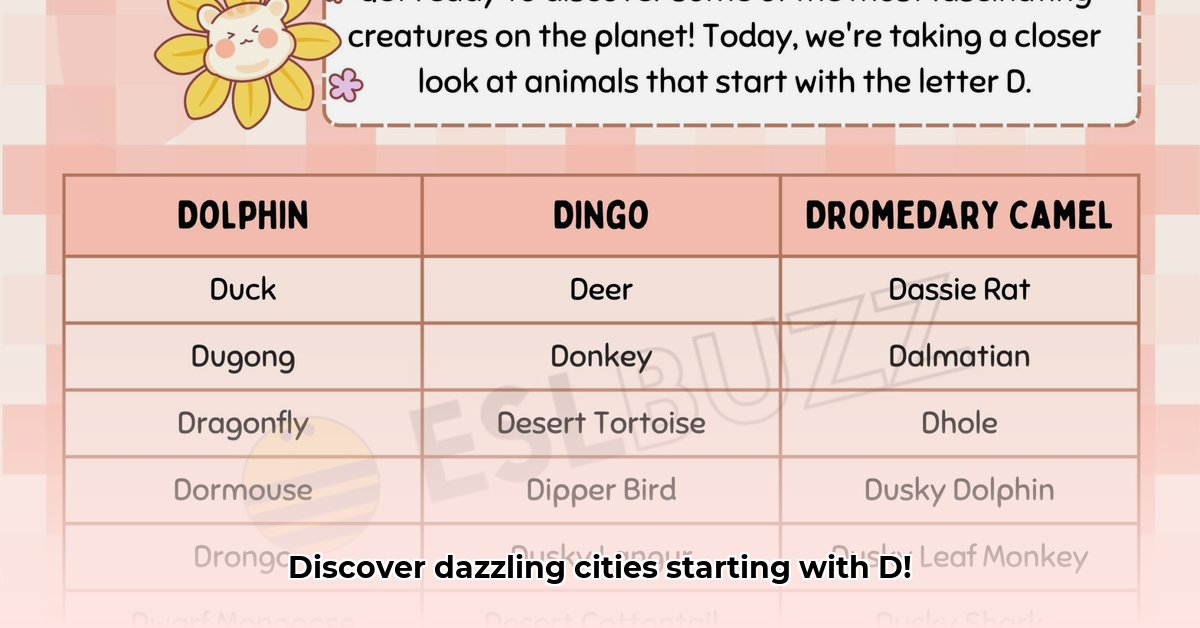Ever wonder what cities starting with the letter “D” have in common? From massive megacities to meticulously planned modern marvels, “D” cities around the world showcase a huge range of how cities grow and succeed. This article explores some of these diverse places, comparing their sizes, economies, and histories to understand what makes them unique. We’ll examine the challenges of rapid growth in Delhi and Dhaka, the innovative planning of Dubai, the economic strength of Dallas, and the preservation efforts in Dresden to uncover what these fascinating cities can teach us about building thriving, sustainable urban centers.
Cities That Start With D: A Global Urban Analysis
Let’s begin a journey to explore the amazing variety of cities whose names begin with the letter “D.” From huge metropolises teeming with millions to smaller, charming towns, these urban centers offer a fascinating glimpse into the diverse tapestry of human civilization and urban development across the globe. While they share a common first letter, their stories are incredibly unique and offer valuable insights into how cities grow, change, and thrive.
A World of “D” Cities: Population, Power, and Personality
The sheer range in population size among “D” cities is truly significant. We’re talking about everything from gigantic megacities struggling to manage explosive growth to smaller, more manageable urban areas with their own distinct challenges and opportunities. This size difference often reflects different phases of economic development and the historical context in which these cities evolved. Population dynamics greatly impact a city’s developmental trajectory.
| City | Region | Approximate Population (2024 Estimates) | Defining Characteristics |
|---|---|---|---|
| Delhi, India | South Asia | ~32 million | A sprawling megacity, a vibrant mix of ancient history and modern challenges, known for its bustling markets, historical monuments, and significant air quality issues. |
| Dhaka, Bangladesh | South Asia | ~23 million | A rapidly growing city facing significant infrastructure strains yet displaying remarkable resilience and cultural vibrancy, a major hub for the garment industry. |
| Dubai, United Arab Emirates | Middle East | ~4.5 million | A modern marvel, a global hub for trade and finance, showcasing stunning architecture, ambitious development projects, and a focus on luxury tourism. |
| Dallas, Texas, USA | North America | ~1.35 million | A significant economic powerhouse in the U.S., renowned for its contributions to technology, finance, and the arts, headquarters to numerous Fortune 500 companies. |
| Davao City, Philippines | Southeast Asia | ~1.8 million | Known as the “Durian Capital”, known for its rich cultural heritage, stunning natural beauty (Mount Apo), and delicious local cuisine that blends indigenous, Muslim, and Christian influences. |
| Depok, Indonesia | Southeast Asia | ~2.1 million | A city known for its educational institutions, vibrant arts scene, and family-friendly atmosphere, home to the University of Indonesia. |
| Durango, Mexico | North America | ~175,000 | A charming historic city with a rich colonial past, surrounded by stunning natural beauty and offering a slower pace of life, known for its well-preserved architecture. |
| Dresden, Germany | Europe | ~560,000 | A city with a remarkable history, known for its cultural heritage, baroque architecture, and its ongoing revitalization after WWII, a center for arts and innovation. |
| Denver, Colorado, USA | North America | ~740,000 | A thriving city nestled in the Rocky Mountains, combining a growing economy with outdoor recreation opportunities like hiking and skiing, and a booming tech sector. |
| Dakar, Senegal | West Africa | ~4 million | A vibrant capital city known for its lively markets, distinctive music scene, and the Dakar Rally, a blend of West African traditions and French colonial influences. |
Economic Engines: How “D” Cities Make Their Money
The economic activities that drive these “D” cities are just as diverse as their populations. Some, like Dubai and Dallas, boast diverse economies, with finance, technology, international trade, and tourism as major components. Other “D” cities depend more heavily on specific industries, such as manufacturing or tourism. This difference in economic focus reflects distinct historical paths and strategic choices. The question of whether economic diversification is always the “best” approach depends on a city’s unique circumstances. Focusing on a niche can create unique strengths, while others advocate for a broad, resilient economy. Davao City thrives on agriculture (durian), trade, and tourism. Dhaka is a major garment manufacturing hub. Denver is experiencing growth in technology and aerospace.
History’s Hand: Shaping the Character of “D” Cities
History plays a powerful role in shaping the character of every city on our list. Ancient cities like Delhi offer centuries of rich cultural heritage, visible in their architecture, cuisine, and markets. Damascus, one of the oldest continuously inhabited cities, showcases historical significance and traditional craftsmanship. In contrast, Dubai’s recent growth paints a different picture of rapid urban transformation and modernization. The past shapes the present, so understanding this historical context is crucial to grasping the unique personality of each “D” city. For instance, Dresden’s recovery from wartime destruction is an ongoing story of resilience and careful reconstruction of its historical landmarks.
Beyond the Numbers: The Challenges and Opportunities
While population figures and economic data provide a valuable framework, a truly comprehensive look requires delving deeper. Issues such as infrastructure development, sustainable environmental practices, social equality, and affordable housing deserve investigation. Data offers an overview, but a more detailed analysis is needed. Dhaka faces immense challenges of overpopulation, pollution, and traffic congestion. Delhi grapples with air quality issues. Ongoing research continues to explore these factors and their interplay in shaping the future of urban spaces around the globe.
Sustainable Development Strategies: Comparing Approaches
Cities starting with “D” offer diverse approaches to sustainable urban development. Dubai invests heavily in renewable energy and green building technologies. Dresden focuses on preserving its historical center and promoting sustainable tourism. Denver aims to balance economic growth with environmental conservation and outdoor recreation. Dhaka and Delhi face significant challenges in improving air quality, managing waste, and providing access to clean water and sanitation for all residents.
The diversity found amongst cities starting with “D” highlights the multifaceted nature of global urban development. Each city offers unique insights and valuable lessons for urban planners, investors, researchers, and anyone interested in the fascinating evolution of human settlements. This exploration is ongoing, and there’s much to discover about these dynamic urban centers. Further research could focus on comparative studies of urban resilience, the impact of globalization on different city types, or the effectiveness of different sustainable development strategies.
How to Compare Sustainable Urban Development Strategies in Rapidly Growing D-Cities
Key Takeaways:
- Sustainable urban development needs a balanced approach: economic progress, social fairness, and environmental protection must work together, ensuring long-term resilience.
- While cities are making strides in green spaces and public transit, funding, political will, and community involvement remain key hurdles, requiring commitment for success.
- Successful strategies depend on each city’s unique circumstances and local government capabilities, necessitating tailored planning.
Diverse “D” Cities: A Snapshot
Let’s explore the fascinating world of cities beginning with the letter “D.” These urban centers, each with its unique character, offer a compelling case study for understanding how to compare sustainable urban development strategies in rapidly growing D-cities. These diverse cities illuminate strategies for balanced growth. Here are a few examples:
| City | Description | Key Data Point |
|---|---|---|
| Dallas, Texas | A sprawling metropolis in the American Southwest, known for its vibrant economy and architecture. | Population: ~1.35 million |
| Dhaka, Bangladesh | One of the world’s most densely populated cities, facing immense infrastructural challenges. | Population: ~23 million+ |
| Dresden, Germany | A historic city in eastern Germany, rebuilding after wartime destruction & preserving heritage. | Significant industry: Tourism |
| Dubai, UAE | A global hub of finance and tourism, with ambitious architectural projects and rapid growth. | GDP per capita: Extremely High |
| Durban, South Africa | A coastal city with a mix of African, Indian, and colonial influences. | Key industry: Tourism and Port Activities |
Comparing Development Strategies: Population Variance
The population variation among these cities is striking. Dhaka’s population presents different challenges from Dresden. Dhaka’s rapid growth necessitates different solutions compared to Dallas, which has a much lower population density and different resource constraints. How to compare sustainable urban development strategies in rapidly growing D-cities requires acknowledging these size differences. What infrastructure investments are crucial for sustainability? Dhaka needs investments in public transportation, sanitation, and affordable housing. Dallas requires improvements in public transportation and addressing suburban sprawl.
Economic Diversification: A Comparative Lens
The economic bases of these cities are diverse. Dubai’s economy relies on tourism and finance, while Dresden boasts a diversified mix of traditional and high-tech industries. Dhaka faces the challenge of balancing growth with sustainable practices. Analyzing these differences can reveal successful models of economic diversification that contribute to sustainable growth. We can find insights into how to compare sustainable urban development strategies in rapidly growing D-cities by examining how each city tackles its economic challenges. What are examples of economic
- Exotic Girl Names Reflecting Diverse Cultures And Unique Beauty - December 11, 2025
- Exotic Female Names Offer Cultural Richness and Unique Sounds - December 10, 2025
- Exotic Baby Girl Names Evoking Far-Off Lands and Beauty - December 9, 2025










